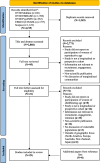Engaging, recruiting, and retaining pregnant people from marginalized communities in environmental health cohort studies: a scoping review
- PMID: 40050851
- PMCID: PMC11887406
- DOI: 10.1186/s12889-025-22033-7
Engaging, recruiting, and retaining pregnant people from marginalized communities in environmental health cohort studies: a scoping review
Abstract
Objectives: To identify barriers to and strategies for improving the representation of pregnant people from marginalized communities in pregnancy cohort studies that measure environmental chemicals.
Methods: Guided by the Arksey O'Malley and Levac Frameworks, we conducted a scoping review of peer-reviewed literature published between 2000 and 2022. Included studies discussed barriers and/or strategies related to engaging, recruiting, and retaining pregnant participants or participants of reproductive age from marginalized communities into environmental health research.
Results: Twenty-nine peer-reviewed articles were included in the review. Overall, 31% (9/29) of the studies reported on engagement, recruitment, and retention of participants from racialized communities, 10% (3/29) reported on involvement of participants identifying as Indigenous, and 10% (3/29) of studies reported on participants living in households or areas of low socioeconomic status. We identified four key barriers: participant burden, social inequities, lack of trust, and lack of cultural relevance. We reported identified strategies to mitigate these barriers.
Conclusion: Although there is limited coverage in the literature on strategies to effectively engage people from marginalized communities in environmental health pregnancy cohort studies, our findings suggest that applying a health equity and social justice lens to research may help address barriers that exist at the individual, interpersonal, community, institutional, and policy levels. Findings from this review may have important implications for planning future pregnancy cohort studies and ensuring that communities who are disproportionately affected by environmental chemical exposures may be better represented in research and considered in policy decisions.
Keywords: Cohort; Engagement; Environmental chemicals; Marginalized; Pregnancy; Recruitment; Retention.
© 2025. Crown.
Conflict of interest statement
Declarations. Ethics approval and consent to participate: Not applicable. Consent for publication: Not applicable. Competing interests: GF received a contract from Health Canada to conduct the scoping review.
Figures



Similar articles
-
Barriers and strategies for recruitment of pregnant women in contemporary longitudinal birth cohort studies.BMC Med Res Methodol. 2025 Apr 28;25(1):117. doi: 10.1186/s12874-025-02570-w. BMC Med Res Methodol. 2025. PMID: 40295914 Free PMC article.
-
Beyond the black stump: rapid reviews of health research issues affecting regional, rural and remote Australia.Med J Aust. 2020 Dec;213 Suppl 11:S3-S32.e1. doi: 10.5694/mja2.50881. Med J Aust. 2020. PMID: 33314144
-
Using Social Media to Engage and Enroll Underrepresented Populations: Longitudinal Digital Health Research.JMIR Form Res. 2025 Apr 15;9:e68093. doi: 10.2196/68093. JMIR Form Res. 2025. PMID: 40233355 Free PMC article.
-
Barriers and facilitators to recruitment of South Asians to health research: a scoping review.BMJ Open. 2017 Jun 1;7(5):e014889. doi: 10.1136/bmjopen-2016-014889. BMJ Open. 2017. PMID: 28576896 Free PMC article.
-
Effective interventions to increase representation of under-served groups in randomised trials in UK and Ireland: a scoping literature review.NIHR Open Res. 2024 Mar 25;4:12. doi: 10.3310/nihropenres.13524.1. eCollection 2024. NIHR Open Res. 2024. PMID: 39297143 Free PMC article.
Cited by
-
Barriers and strategies for recruitment of pregnant women in contemporary longitudinal birth cohort studies.BMC Med Res Methodol. 2025 Apr 28;25(1):117. doi: 10.1186/s12874-025-02570-w. BMC Med Res Methodol. 2025. PMID: 40295914 Free PMC article.
References
-
- Wigle DT, Arbuckle TE, Walker M, Wade MG, Liu S, Krewski D. Environmental hazards: evidence for effects on child health. J Toxicol Environ Health B Crit Rev. 2007;10(1–2):3–39. - PubMed
-
- Eaton W. The logic for a conception-to-death cohort study. Ann Epidemiol. 2002;12:445–51. - PubMed
-
- Frank J, Di Ruggiero E, McInnes RR, Kramer M, Gagnon F. Large life-course cohorts for characterizing genetic and environmental contributions: the need for more thoughtful designs. Epidemiology. 2006;17:595–8. - PubMed
Publication types
MeSH terms
LinkOut - more resources
Full Text Sources
Medical

